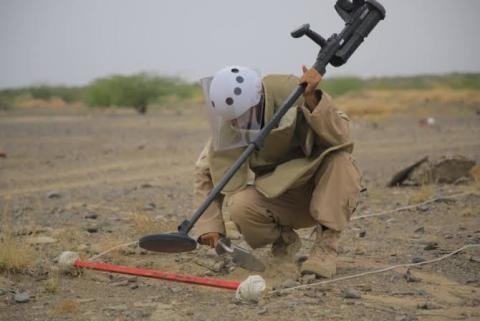Houthis in Yemen, a new old story


It may be astonishing to some that religious sources for the Zaidi sect of Shia Islam, to which Yemen's Houthis belong, consist only of manuscripts in the library of the Great Mosque in the Yemeni capital Sana'a or owned by individual Zaidis. But this is because this sect's believers are almost entirely restricted to Yemen.
The Zaidi sect is perhaps the least understood in Islam, and has the smallest amount of literature published about it. This seems to be why the book's author, Judge Al-Dimerdash Al-Aqaali, took on the subject.
The author devotes most of the book to the creedal facets of this sect and its relationship with the Sunnis and with other Shia sects.
The war currently raging in Yemen, in which both regional Arab powers and Iran have taken sides, holds some its roots in Yemen's history.
Persian (or Iranian) relations with Yemen date back to as far as the sixth century AD, when the Yemeni Prince Sayf ibn Zi Yazan travelled to the capital of Persia and met the Persian king asking his help in repelling the constant Abyssinian raids on his lands. The king sent with him a military expedition that enabled him to extend control over the whole of Yemen. But the early decades of the seventh century witnessed a gradual disappearance of the Persian presence.
In the ninth century, the Persians had further interests in the country after it became Islamic.
From these kingdoms, a Zaidi kingdom was established in Gilan, whose people followed Zayd ibn Ali, grandson of Husain ibn Ali, and considered him to be their religious leader, while other Shia sects regarded another grandson, Imam Muhammed Al-Baqir, as their guide.
This Zaidi kingdom ruled from 864 AD until 928 AD.
Due to the pressures it suffered from other surrounding kingdoms and dynasties, it sent advocates to other Islamic kingdoms in search of supporters.
What is surprising is that it was successful in establishing small communities and kingdoms in the middle of the Arabian Peninsula, North Africa, southern Spain and Yemen.
Today, while the Zaidi sect has almost disappeared in these areas, it has thrived in Yemen.
When Yemen fell in to the influence sphere of the Ottoman Empire, but wasn't annexed administratively as an Ottoman Vilayat, communication with Iran diminished.
The Safavid dynasty also embraced the Twelver Shia sect, and it became the official denomination in Iran.
This added a political dimension -- in addition to the theological differences which already exist -- between the two sects.
During the 1960s, Iran's Shah Mohammad Reza Pahlavi was worried that Yemen might fall under Nasserite control. Iran moved by heavily backing Imam Al-Badr bin Ahmad in the Yemeni civil war.
However, when leftist groups and organisations seized power in South Yemen, this led to a direct military intervention in which Iran was engaged in fierce battles in both South Yemen, as well as the Dhofar governorate in the Sultunate of Oman, in order to hinder a stable leftist rule which threatened Iranian interests and its oil pipelines, during the time of the Cold War with its well-known global polarisation.
In 1974, Iran found a strong ally in Lieutenant-Colonel Ibrahim Al-Hamdy, who seized power in a military coup d'état aided by his successor Ali Abdullah Saleh. His rule was one of the periods that witnessed the rise of mutual relations between both countries in different fields.
It reached the extent that the Shah assigned one of his powerful generals with the task of changing the Soviet structure of the Yemeni army, which had been set up under Nasserite influence. In 1977, Iran lost its ally Al-Hamdy when he was killed during a military coup d'état led by Ali Abdullah Saleh.
As for the roots of the Houthis, whose rebel movement has now taken over several cities in Yemen, they date back several centuries, according to the author Judge Al-Aqaali.
The Zaidis continued to rule Yemen until 1962, when the Yemeni revolution broke out against the Zaidi imamate, leading to Yemen becoming a republic.
After about a quarter of a century, an advocate group teaching the Zaidi denomination called the Believing Youth Federation emerged in Saada, a governorate bordering Saudi Arabia to the north of Sana'a.
Among its teachers was Badreddin Al-Houthi.
After Yemeni unification in 1990, the Believing Youth Federation was transformed into the Haqq Party (Truth Party) as a representative of the Zaidis. At this stage, Hussein Al-Houthi, the son of Badreddin, emerged as one of the most prominent political leaders within the party and became a member of parliament.
In 2002, Hussein Al-Houthi left the Haqq Party and embraced the following motto: "God is Great, Death to America, Death to Israel, Curse on the Jews, Victory to Islam."
In 2004, Yemen witnessed led by demonstrations led by Hussein Al-Houthi which were mercilessly crushed, with Hussein being killed. His brother Abdel-Malik took over leadership of the group.
From this time on, the group began to arm itself with good weaponry in preparation for the current war which broke out after the direct military intervention led by Saudi Arabia.
Finally, one of the most significant repercussions of this war is the split and division in the Yemeni army between the supporters of the former president and one of the most dangerous players on the political stage now, Ali Abdullah Saleh, and the backers of the internationally-recognised President Abd Rabbuh Mansur Hadi.
Ahram

Yemeni officials on Monday condemned arrests and prosecutions by the Iran-backed Houthi militia directed against media, journalists and celebrities…

Yemen's warring parties are gearing up for new waves of conflict in 2023 amid a lack of decisive steps towards sustainable peace, adding to the suf…

The UAE will help to recruit doctors and deliver crucial supplies for hospitals in Yemen under a major healthcare drive. The Khalifa bin…